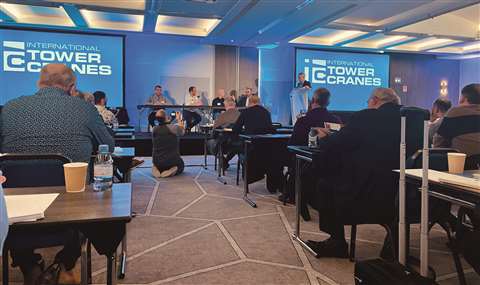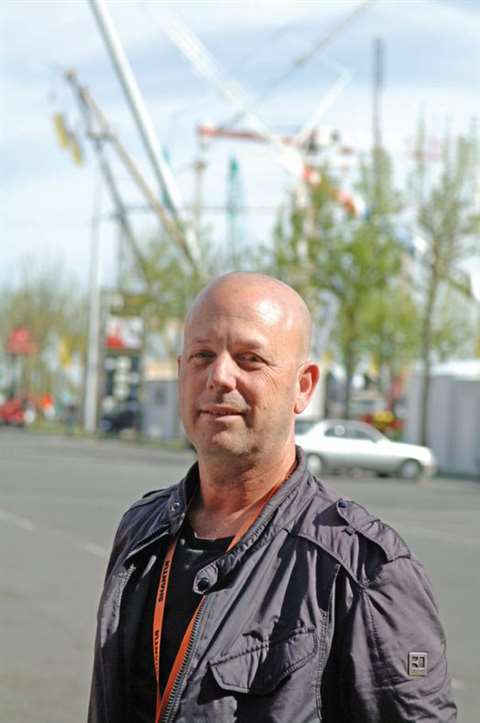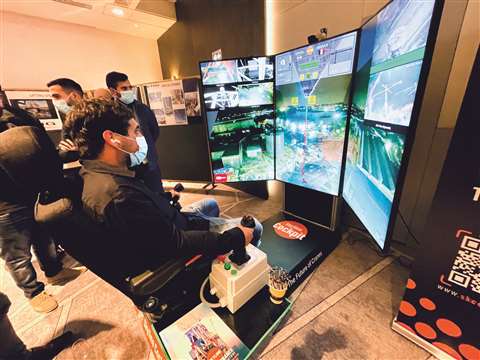Tower crane tech presents new opportunities, says SC&RA
24 February 2022
Technology in the tower crane sector presents a world of opportunity, reports Mike Chalmers from the recent International Tower Cranes conference in France.
As it has done throughout the construction and transport industries around the world, technology continues to work its way into the systems and processes of just about every sub-industry therein – with tower cranes emerging as a hot topic of late.
 The International Tower Cranes (ITC) conference in Nice, France on 1 and 2 December 2021
The International Tower Cranes (ITC) conference in Nice, France on 1 and 2 December 2021
Technology was a key theme late last year at the International Tower Cranes Conference (ITC), of which SC&RA was an event partner, held in Nice, France. One particular round-table discussion – Automation and remote control of tower cranes – highlighted the level of both sophistication and enthusiasm surging through this particular space.
Two members of the four-person discussion were Aviv Carmel, joint founder and general manager, Skyline Cranes and Technologies in Israel, and CEO at Skyline Cockpit; and Jean-Charles Delplace, CEO at SMIE in France, and CEO, Smart Jobsite. Both men represent the two-sided coin that inevitably finds itself being flipped within technology conversations in construction the world over – i.e., while they both are engaged in highly technological and innovative iterations on tower crane operation, they don’t necessarily agree on the best path forward. In this instance, a debate emerged over remote operation of tower cranes.
Part of the journey
With 32 years of personal experience working with tower cranes, Carmel explained that Skyline is determined to close the gap between the needs and challenges inherent within the industry. “We have more than two hundred towers on rental, and service about forty percent of the local market – we’re always looking above and beyond to the next level.”
And Carmel believes that next level sits a couple hundred feet above the ground. “The tower crane hasn’t had any significant changes in recent decades,” he pointed out. “Other than structural design reviews, it has basically remained a construction site lifting machine with an operator up there. That said, there are many built-in problems and limitations that everyone takes as a necessary evil, but new technological capabilities allow us to change our perception.”
 Jean-Charle Delplace is CEO at SMIE and Smart Jobsite (Photo: SC&RA)
Jean-Charle Delplace is CEO at SMIE and Smart Jobsite (Photo: SC&RA)
Carmel ultimately asked himself, if everything was possible, what would he like to change about tower cranes. “And the answer was: the operator should not be up there, or on site at all,” he confirmed. “The crane should operate via C.A.A.S. (crane as a scanner). We’re up there using technology – we see everything into the crane and out to the site. We should operate it as a tower control centre, harvesting all the information. Data is the new gold – acquired, processed and delivered to the right customers.”
The result of Carmel’s thinking led to Skyline Cockpit – a groundbreaking technology that enables operators to control cranes remotely from anywhere, “…significantly enhancing the crane’s efficiency and productivity, while creating a friendly, safe environment for the operators.”
It should be highlighted that Skyline Cockpit has successfully been in operation for over a year on projects that Skyline is affiliated with. To that end, Skyline had an operator onsite at ITC working a job back in Israel in real-time, seemingly without issue.
“It’s about efficiency, safety, cost and value,” emphasised Carmel. “And the future is now; we’re already here. We’re operating with a stable product off-site, including the ability to operate more than one crane from the same cockpit with a single operator, switching from one to another. R&D is operating and monitoring different cranes at different sites in different cities.”
It’s all part of a journey, maintained Carmel, beneath the banner of “change” – whereby in the short term, those who get on board early (OEMs, regulators, rental companies, etc.) and adopt the technology will have the advantage. “And long-term,” he added, “it’s the evolution of the whole industry – understanding that change is actually part of the journey.”
Jobsite connection
But not everyone is as keen as Carmel and some of his industry colleagues on remote tower crane operation – evidenced by Delplace’s direct criticism of it during the round-table discussion.
Which isn’t to say that Delplace, and his companies, aren’t directly involved in the technological evolution of the industry. Remote operation, however, isn’t a pursuit that he sees as worthwhile.
 Aviv Carmel, joint founder and general manager at Skyline Cranes and Technologies in Israel and CEO at Skyline Cockpit (Photo: SC&RA)
Aviv Carmel, joint founder and general manager at Skyline Cranes and Technologies in Israel and CEO at Skyline Cockpit (Photo: SC&RA)
“We are certainly devoting technology to the future of this industry,” he stressed. “We see a great future in the construction industry – and in my personal view, as much as we [the industry] are late with tech, I truly believe that construction will go through a huge mutation in the next few years and beyond. But we don’t see remote operation as a safe, efficient part of that future.”
Delplace elaborated, “We [SMIE and Smart Jobsite] are developing a lot of things – we’ve developed a crane simulator that everyone saw onsite at the conference,” he noted. “It’s great for many reasons, but one is that it’s a platform to make the experiment between remote operation and self-driving.”
For context, Delplace and SMIE are leaning heavily into self-driving, versus remote operation. “We’ve been very impressed with it, and it can be used tomorrow morning,” he indicated. “We started with the same sort of feeling that it would happen over a long period of time, but we’ve changed our minds – there could be integration quite soon actually.
“But from those experiments, we’ve also experimented heavily with remote operation, and we saw quite a few issues. First, it’s not sorting anything out – it just moves the operator away from being on top of a crane. And from where we stand, that adds more complexity, it doesn’t reduce costs and it actually complicates the idea of the crane operator.”
Leveraging both the increased cost, safety concerns and technical complexity that Delplace and SMIE discovered during two comprehensive trials, he also landed on another belief. “It’s hard to describe, but when you try the remote driving, you feel like you’re in a video game,” he explained. “Yes, it’s brilliant – you can add in the crane movement and sound, etc., but we found that when you step out of the crane, you lose the sense of danger associated with the job itself. And that’s the main thing that has stopped us from developing it any further. It simply feels too disconnected – if you strike someone, it’s not quite the same. It’s a loss of connection from the jobsite because you’re not there in-person. So that’s why I said on the panel that we thought it was extremely dangerous. We simply believe it creates more problems than it solves.”
The way forward
Conversely, Delplace believes that self-driving (automated) cranes have a huge future within the industry. “While we know there will be enormous legal hurdles to get over in the years to come, we are one hundred percent in support of self-driving cranes,” he said.
 Skyline’s equipment set up at the ITC in France from where a tower crane in Israel was controlled
Skyline’s equipment set up at the ITC in France from where a tower crane in Israel was controlled
“It’s the way forward from where we stand. Indeed, while we believe the technology is there, in our view, construction is not compatible with self-driving at this moment. That said, on so many current jobsites, people are late, material is lost, logistical components are compromised – inefficiencies are everywhere. We know that industry is going to have to change, however long it takes – and not just cranes, but construction methods, modalities. But ultimately, the crane will be much more than a lifting device, and self-driving will be a key piece of the process.”
To that point, Carmel agreed. “This is not science fiction; though the journey will take a while and require many small steps. We’re taking the industry out of its comfort zone, but someone has to lead – and eventually, the rest will follow. Any change manifests resistance but, in this case, the change is already happening. I would suggest to the whole of the industry – manufacturers, rental companies, end-users, construction companies, regulators – to change their point of view, look wider and deeper. We are blessed to be in a time of such change and opportunity.”
STAY CONNECTED


Receive the information you need when you need it through our world-leading magazines, newsletters and daily briefings.



